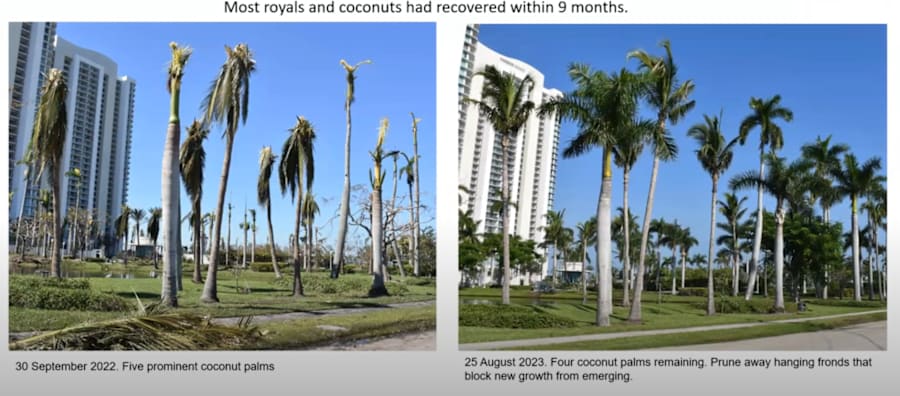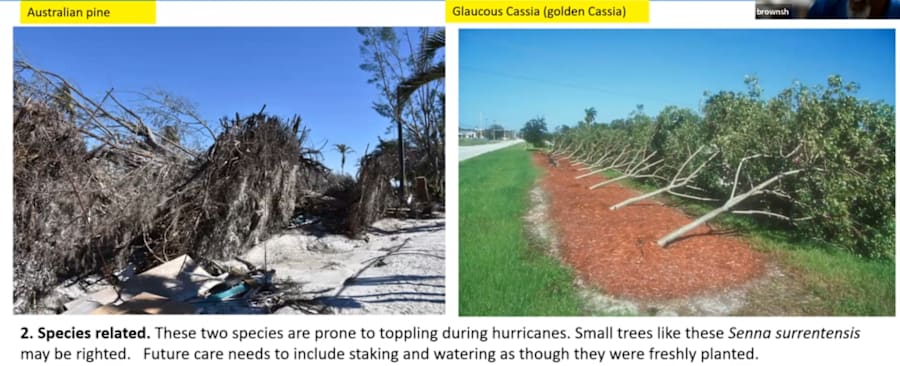FORT MYERS, Fla. – Selecting appropriate landscape plants is critical to minimizing damage from hurricanes. Wind-resistant shrubs, ground cover, and native plant species can help reduce future losses.
After Hurricane Milton snapped trees and denuded their leaves, people may be looking for alternative species that could withstand the conditions.
Recommended Videos
For communities in hurricane-prone areas, planning with the right plant species can significantly improve the landscape’s weathering of the next storm.
TROPICS UPDATE: Chances of a tropical cyclone in the next 7 days continue to decrease
Not all is lost despite the immediate devastation from the hurricane, some native and non-native species will recover over time.
In the aftermath of Hurricane Ian in 2022, the University of Florida’s Institute of Food and Agricultural Sciences Extension office agent Stephen Brown in Lee County looked at which plants and trees handled the storm better than others.

Palm Trees: While many palms, like royal palms and coconut palms, demonstrated remarkable resilience, others, such as Bismarck palms and Queen palms, proved less tolerant to strong winds and storm surge.
Trees: Some trees, like gumbo limbos and West Indian mahoganies, showed impressive recovery abilities, while others, such as Cuban laurels, were severely damaged or killed.
Shrubs: Certain shrubs, including green buttonwoods and sea grapes, exhibited notable resilience, while others, like red-tip plumerias, succumbed to the storm’s harsh conditions.
Be watchful in the months after a storm for pine tree health. Many will die off or lose their needles, becoming more susceptible to beetle infestations.

Oak trees generally survive hurricanes but will easily tip out of the ground when they have been planted in areas where tree roots are confined by roads, sidewalks, or buildings.
Best and Worst Landscape Plants:
Most Resilient Palms: Cabbage/Sabal palms are the best but Pygmy date palms can be more resistant to our native Cabbage palm. Christmas palms are likely the second most wind and surge tolerant but they don’t handle our cold winters well. Warm weather bottle palms and spindle palms emerged as the most wind-resistant non-native palms. Among native palms, cabbage palms and Florida thatch palms demonstrated exceptional resilience.
Least Resilient Palms: Bismarck palms are the most intolerant and Queen palms tend to break in the wind. Foxtail palms don’t hold up well because the fronds drop and their crowns will split. This will also make them less hardy during the following cold season winters.
Resilient Shrubs: During Hurricane Matthew, Green and Silver Saw Palmetto sprouted green growth just one month after the storm. The underground stems don’t get damaged and are sure to return to normal. Green buttonwoods, sea grapes, and certain plumeria varieties also show resilience to storm conditions.

The storm’s impact on trees was notable. Tree loss varied based on species, age, health, and structure, alongside local soil conditions and the duration of the hurricane. Common tree damage included leaf loss, broken branches, leaning trunks, and uprooted trees.
In Fort Myers Beach, trees like gumbo limbos and palms lost significant foliage, though many, such as royal and coconut palms, demonstrated their resilience by recovering within a year.



